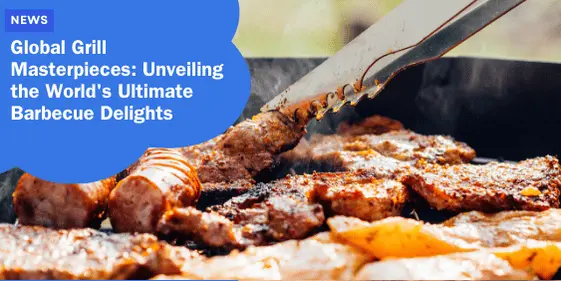Global Grill Masterpieces: Unveiling the World’s Ultimate Barbecue Delights

Americans are often celebrated as masters of the grill, with their parks and backyards filled with the aroma of sauce-slathered chicken and meats.
However, the barbecue culture extends far beyond the borders of the United States.
From Argentina to Japan, and from the Philippines to Fiji, each corner of the world boasts its own unique and cherished barbecue traditions.
Let’s take a deeper look into some of the most iconic and mouth-watering barbecue styles from around the globe.
Braai – South Africa
In South Africa, the term “braai,” derived from Afrikaans meaning “barbecue,” represents more than just a cooking method it embodies a cherished cultural tradition.
Whether in urban areas or rural townships, the braai brings together friends and families over juicy cuts of steak, sausage, and chicken sosaties (skewers).
Unique Love, a Chicago native who spent several years in Cape Town, fondly recalls the vibrant atmosphere of a traditional South African braai at Mzoli’s Meat in Cape Town.
Here, the community ambiance and flavorful meats create an unforgettable experience that resonates deeply with locals and visitors alike.
Asado – Argentina
Argentina’s love affair with barbecue, known locally as “asado,” rivals any other in the world.
Argentinians take immense pride in their asado gatherings, which are more than just meals they are social events that occur weekly.
Guillermo Pernot, chef-partner of Cuba Libre Restaurant & Rum Bar, emphasizes the importance of using specific cuts and meats for the perfect asado experience.
The ritualistic preparation, from marination to grilling over open flames, ensures that each bite is a testament to Argentina’s rich culinary heritage.
Yakitori – Japan
Yakitori, a beloved street food in Japan, consists of skewered chicken pieces grilled over a charcoal fire.
The simplicity of yakitori lies in its preparation: diced chicken parts, from tender thigh meat to flavorful chicken skin, are expertly grilled and often served with a side of tare sauce.
Tanya Spaulding, a travel blogger, recommends enjoying yakitori at street vendors or traditional settings, where diners can cook their skewers over a shichirin grill.
This interactive dining experience adds to the charm of yakitori, making it a favorite among locals and tourists alike.
Churrasco – Brazil
In Brazil, churrasco refers to more than just barbecue—it’s a feast of epic proportions.
Visitors to Brazil often indulge in churrascarias, where servers carve an endless array of grilled meats directly at the table.
Dan Clarke from RealWorld Holidays notes that Brazilian churrasco offers a diverse range of options, including extensive salad bars alongside the meat-centric dishes.
This inclusive approach ensures that everyone, including vegetarians, can savor the Brazilian barbecue experience with its vibrant flavors and festive atmosphere.
Lechon – Philippines
Lechon, the pride of Filipino cuisine, involves roasting a whole suckling pig over an open fire or charcoal pit.
Celebrated as the national dish of the Philippines, lechon holds a special place in local festivities and gatherings.
Erin Yang highlights the Parada ng Lechon in Balayan, Philippines, where roasted pigs are paraded through the streets in a festive display of culinary tradition.
The succulent, crispy skin and tender meat of lechon make it a must-try for anyone exploring Filipino cuisine.
Tandoor – India
India’s tandoor oven, a cylindrical clay oven, is renowned for its ability to produce aromatic and flavorful dishes.
Tandoori chicken, a popular barbecue item, is marinated in a blend of yogurt and spices before being cooked in the tandoor at high temperatures.
Chef Manjit Gill explains that tandoori cooking originated centuries ago in Central Asia, evolving into the vibrant tandoori cuisine enjoyed today across India and beyond.
The smoky flavors and tender textures of tandoori dishes continue to captivate palates worldwide.
Mongolian BBQ – Taiwan
Despite its name, Mongolian barbecue finds its roots in Taiwan, where it has evolved into a beloved culinary tradition.
Erin Yang reveals that Mongolian barbecue in Taiwan involves quick cooking of sliced meats, noodles, and vegetables on a flat metal grill.
Monica Weintraub, a food blogger in Beijing, notes that variations of Mongolian barbecue are also popular in northern China, highlighting the use of robust seasonings like chili powder and cumin seeds to enhance the flavors of beef and lamb dishes.
Lovo – Fiji
Fiji’s traditional barbecue, known as lovo, takes a unique approach with an earth oven used for slow-cooking meats and vegetables.
Erin Yang describes how hot stones are placed into a pit lined with banana leaves, creating a smoky and aromatic cooking environment.
The communal aspect of preparing and enjoying lovo adds to its appeal, making it a centerpiece of Fijian celebrations and cultural gatherings.
Umu – Samoa
In Samoa, umu represents a traditional underground barbecue method where hot stones are used to cook a variety of foods wrapped in banana leaves.
Avichai Ben Tzur shares insights into the preparation process, which involves gathering fresh ingredients and communal cooking rituals.
The umu feast often includes palusami, a dish of coconut cream and taro leaves, adding richness and flavor to the meal shared among family and friends.
Gogigui – Korean Peninsula
Korea’s gogigui, or Korean barbecue, offers a dynamic dining experience where diners cook thin slices of beef, pork, and chicken at their table.
Diane Sooyeon Kang, a Masterchef Korea finalist, provides cooking tips for achieving the perfect gogigui, emphasizing high heat for caramelization and juicy textures.
Jessica Mehta recommends pairing Korean barbecue with soju, a traditional Korean liquor, to complement the savory flavors of the grilled meats and banchan side dishes.
Pachamanca – Peru
Peru’s ancient Incan cooking tradition, pachamanca, involves using an earth oven to slow-cook meats, potatoes, and vegetables wrapped in banana leaves.
This ceremonial cooking method, dating back centuries, remains a symbol of cultural heritage and community bonding during special occasions and festivities.
The aromatic flavors and tender textures of pachamanca dishes showcase Peru’s rich culinary diversity and its deep connection to indigenous traditions.
Conclusion
From the vibrant asados of Argentina to the aromatic tandoori chicken of India, and from the festive lechon of the Philippines to the communal umu of Samoa, barbecue traditions around the world reflect the diversity and cultural richness of each region.
Whether it’s a weekend gathering with family or a festive celebration, the universal appeal of barbecue transcends borders, bringing people together to savor flavors that have been passed down through generations.
As you explore these global grill masterpieces, remember that the joy of barbecue lies not just in the food itself, but in the traditions and stories that accompany each delicious bite.






